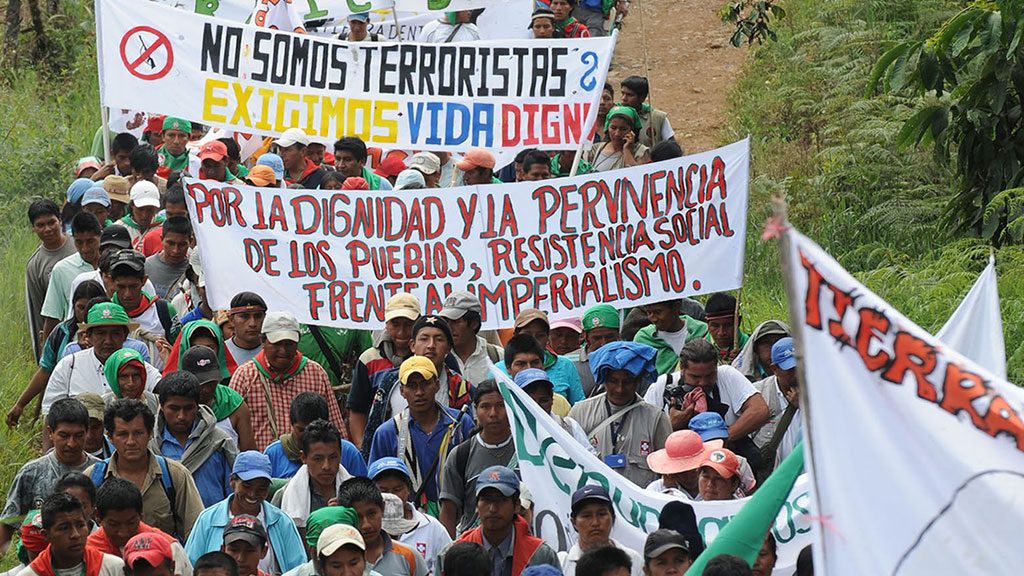An explosive conflict between indigenous people and authorities in southwest Colombia will not be resolved until the government returns thousands of hectares of land that they have been owed for decades, according to indigenous leaders.
The Colombian department of Cauca is currently embroiled in a conflict over the 141,000 hectares of land that the indigenous population of the region claim is entitled to them by the government.
While protests have been ongoing since November last year, they have so far only been met by police repression, leading to growing numbers of injuries for both parties, and deepening unrest as the issue remaining unresolved.
According to local indigenous rights groups, at least 100 protesters and seven soldiers have been injured in clashes.
Indigenous protests in southwest Colombia turn violent, leaving dozens of injured
The indigenous defense has been the occupation of several ranches and surrounding lands in territories they claim are rightfully theirs.
This land in question is now in the hands of large-scale business owners such as soda company Postobon, television network RCN and sugar plantation owner Carlos Ardila Lulle.
Life or death
However, indigenous communities claim that they require this land to cultivate the crops that sustain their populations’ existence.
“We need the land to live,” indigenous leader Feliciano Valencia told Colombia Reports on Tuesday.
“Almost 45% of the Cauca territory is taken up by sugar plantations, which only produce sugarcane. So, one part of our land is devoted to the production of sugar, while the other is for the production of ethanol,” Valencia explained.
The indigenous people of Cauca traditionally provide nutrition through products of their own land. Therefore, without sufficient space to cultivate and harvest crops, the communities are at great risk.
“We are left with not enough food for the people, only fuel for the machines,” insisted Valencia.
The protestors say that the lack of land has even left local indigenous families with nowhere to live, often leading to three or four families sharing a single home.
Governmental promises
Though protests began last November, the issues have been ongoing for decades.
Over the years, the Colombian government has made agreements with the people of Cauca to ensure the sustenance of their communities, which the indigenous claim have not been up kept.
“The government have made agreements with us that have accumulated over time and never been fulfilled,” said Valencia.
“There are laws, judgments, constitutional acts, a development plan to consider. The government cannot forget its responsibility,” the indigenous leader added.
The 1991 agricultural agreement signed by the Colombian government defined frameworks to address such territorial conflict as this.
The state committed to conduct a comprehensive rural reform; to ensure there are ethnic territories; to create instances of territorial cooperation with farmers, indigenous and black people; a deepening of the already existent democracy, and strategies to protect environmental reserves.
The indigenous do not feel this agreement has been fulfilled by the Colombian government.
“Now things change. Now the government cannot only give us a signed document, but should give us back the land,” Valencia affirmed.
Indigenous development
The criticism of the indigenous people to the large-scale businesses using Cauca’s territory is not symptomatic of a resistance for development amongst the communities.
They themselves are planning a strategy to develop – if they had the land at their disposal.
“We are planning a development that does not harm the land, or the environment. We are not looking to destroy the mountains or the rivers,” Valencia told Colombia Reports.
“Yes we want to create business. Yes we want to create industry. Yes we want agricultural development. But without attacking the land and the territory,” assured the indigenous representative.
Willing to compromise
A glimmer of hope within the conflict is the indigenous people’s willingness to enter into compromise with the Colombian government.
Although the communities claim that 141,000 hectares of land should be theirs, an initial figure of 5,000 hectares a year has been cited by multiple indigenous leaders as a step in the right direction.
“If the government and businesses want to contribute, to support the achievement of peace, start with 5,000 hectares,” said indigenous leader Jose Pilcue last week.
“We are not radicals, we are flexible,” reiterated Valencia on Tuesday.
“If they give us 5,000 hectares per year, until 2019, we would hit our first target of 20,000 hectares. From then on, we will search for other mechanisms as we go forward with our proposals,” he explained.
The other side
To solve the stand-off, Interior Minister Juan Fernando Cristo agreed to meet with indigenous leaders in the capital Bogota last week.
“The purpose of today’s meeting is to agree on the conditions for a negotiation table with the government, to come up with some sort of road map,” said indigenous leader Orlando Huellas on local news website Proclama del Cauca.
It remains unclear as to whether progress has been made.
Meanwhile, Senator Paloma Valencia of the Democratic Center proposed the ethnical segregation of the troubled Cauca state on Tuesday.
The conservative said her party would promote a referendum “to decide if we break the department in two,” in the hope the issue of land ownership would disappear.
The suggestion was met with outrage by indigenous leaders.
Sources
Interview with Feliciano Valencia
La paz territorial se define en el Cauca (El Espectador)
ONIC alerta por desplazamiento de más de 600 indígenas en lo corrido de 2015 (RCN Radio)


